Susan Price's Blog: Susan Price's Nennius Blog, page 5
March 11, 2016
"Everything She Ever Wanted" by Ann Rule
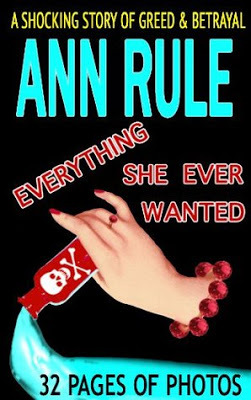 Everything She Ever Wanted
It's hard to believe that this is an account of murders, attempted murders and trials that actually happened. It's way too over the top for fiction. No reader would ever believe it.
Everything She Ever Wanted
It's hard to believe that this is an account of murders, attempted murders and trials that actually happened. It's way too over the top for fiction. No reader would ever believe it.At the centre of it all is the woman born Mary Linda Patricia Vann, but usually known as Pat Allanson.
It is very hard to know what to make of her.
On one hand, she seems to have lived in a fantasy. She not only lived with her parents into old age, but lived on them, at their expense. In fact, her demands drove them into poverty. She seemed to have seen herself as an incarnation of Scarlett O'Hara, and wanted a Southern mansion where she could breed Morgan horses - despite the fact that the cost of such a place was far beyond her means.
She saw herself as a delicate, gentle Southern belle, bravely overcoming her ill-health and frailty. When challenged, she would cry or faint. One of her daughters observed that, despite this fraility, she could easily lift heavy saddles on and off horses' backs - and, in fact her worst illness, an abcess which nearly killed her from blood-poisoning, was self-inflicted. Medical check-ups revealed that, otherwise, she was strong as one of her horses.
Did her fantasy vision of herself, and her wild rages when she didn't get 'everything she ever wanted' mean that she was mentally ill? It certainly seems outside the range of 'sane'.
And yet, she seems to have planned her actions carefully, and covered them up, in a way that doesn't suggest the disordered thinking of madness. She was so cunning that most of the crimes which it seems certain she committed, could not be pinned on her.
So, what did she do? Well, she married Tom Allanson, a blacksmith who had wealthy parents, even though he was estranged from them. Pat Allanson seems to have nurtured the ill-feeling between them.
Her parents-in-law were murdered in their basment, and their son was arrested for the crime. He was certainly present at the time of the killings - he'd gone there at his wife's suggestion, to try and heal the breach between them. He went at a time when he knew his difficult father was at work, and he could talk alone with his mother.
Before going to his parents' house, he dropped his frail, delicate wife at her doctor's for an appointment. So, who was the woman who phoned his father's office and informed him that his son was at his home? Even more mysterious, who cut the telephone wires to the Allanson house?
After Allanson was jailed for murdering his parents, his loving wife arranged control of most of his finances. The failing ranch her husband had bought her burned down and she got the insurance. His grandmother had had a stroke and his grandfather was elderly, so loving Pat moved into nurse them, won their trust, and gained their signature to papers which let her control their finances.
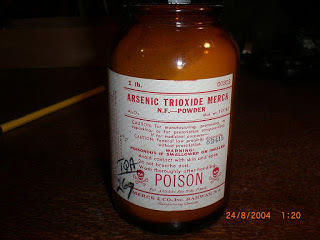 https://en.wikipedia.org/wiki/File:Arsenic_trioxide024.jpgShe tried to convince her jailed husband that he should join her in a suicide-pact. She was older than him, and frail and he was going to be in jail for so long. She couldn't bear to be without him - and the only way they could be together was in death.
https://en.wikipedia.org/wiki/File:Arsenic_trioxide024.jpgShe tried to convince her jailed husband that he should join her in a suicide-pact. She was older than him, and frail and he was going to be in jail for so long. She couldn't bear to be without him - and the only way they could be together was in death.Allanson steadfastly refused. If he'd agreed, and killed himself in prison as Pat Allanson wanted, maybe she would have killed herself to join him - or maybe she would have stayed alive and inherited from him. What do you think?
Allanson's grandfather, under Pat's care, was rushed to hospital and nearly died from a mysterious illness which later turned out to be arsenic poisoning.
Detectives were certain that he'd been poisoned by his loving grandaughter-in-law, Pat Allanson, but they could not prove it. They could not discover where she'd obtained the arsenic or how she'd fed it to the old couple - though some time later a house-sitter became gravely ill after eating hot-dogs and ice-cream from the old people's freezer. Evidence of poisoning, however, had been flushed away and the detectives were frustrated again.
But I could not possibly untangle this woman's criminal career in a short review. Suffice to say, that people who encountered her continued to suffer the symptoms of arsenic poisoning, until the possibility that she was innocent becomes very hard to believe. Among those who suffered long-term painful illness identical to that caused by arsenic poisoning was Pat Allanson's own adult daughter.
Throughout, Pat Allanson's own doting mother maintained that her daughter was innocent and harmless.
The cover may be lurid but don't let it put you off. This is a truly eye-popping account of just how mad those mortals be.
Published on March 11, 2016 16:00
March 4, 2016
Review: 1000 Years of Annoying The French by Stephen Clarke
I came across this book in the bathroom of my esteemed colleague
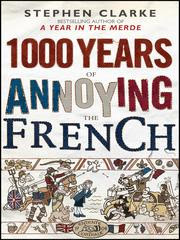 1000 Years of Annoying The French - Clarkeand fellow Author Electric, Karen Bush, while I was staying with her and the whippets.
1000 Years of Annoying The French - Clarkeand fellow Author Electric, Karen Bush, while I was staying with her and the whippets.
I dipped into it and found it so amusing and interesting that I bought my own e-copy.
It is full of hints and tips on how to annoy the French - and some account of how they have succeeded in annoying us.
The thousand years begins, of course, with 1066, the only memorable date in English history, as any fule kno. Stephen Clarke immediately destroys the French's sad illusion that they were the last foreigner to successfully invade us. They weren't - and anyway, the Normans weren't French, they were Vikings, and we already had plenty of them.
For a thousand years, Stephen Clarke is always amusing and very often surprising - I had no idea that French Canadians had such a long history of oppression, mostly by the French. Nor that the Cajuns of the American South are descended from those same troubled French Canadians, who it seems were never allowed to rest in any place very long.
I was also enlightened on the matter of De Gaulle and why he seemed to be so heartily disliked by all my relatives who had lived through the war. I've never taken much interest in the war that immediately preceded my lifetime and had supposed that De Gaulle was disliked simply because he was French and pursued France's interests - as was his business. Clarke's book made me think that there may have been other reasons. For one, the man was an idiot. (That should be annoying.)
Clarke's also keen to tell us that champagne and the guillotine were both invented by the English, and that all French wine is, in fact, American.
Clarke is obviously fluent in French and knowledgable about their customs and history, but I did sometimes get the impression - whether he intended it or not - that he genuinely disliked them and was happy to encourage us to annoy them.
I'm sure I'm wrong on this.
But I'm happy to recommend this book - it's a good read and you end by knowing a lot more about Anglo-French history that you thought you were going to learn.
1000 Years of Annoying the French by Stephen Clarke
 1000 Years of Annoying The French - Clarkeand fellow Author Electric, Karen Bush, while I was staying with her and the whippets.
1000 Years of Annoying The French - Clarkeand fellow Author Electric, Karen Bush, while I was staying with her and the whippets.I dipped into it and found it so amusing and interesting that I bought my own e-copy.
We have been, we are, and I trust we always will be, detested by the French. - Duke of Wellington.
It is full of hints and tips on how to annoy the French - and some account of how they have succeeded in annoying us.
The English, by nature, always want to fight their neighbours for no reason... From the Journal d'un Bourgeois de Paris, written during the Hundred Years War.
The thousand years begins, of course, with 1066, the only memorable date in English history, as any fule kno. Stephen Clarke immediately destroys the French's sad illusion that they were the last foreigner to successfully invade us. They weren't - and anyway, the Normans weren't French, they were Vikings, and we already had plenty of them.
For a thousand years, Stephen Clarke is always amusing and very often surprising - I had no idea that French Canadians had such a long history of oppression, mostly by the French. Nor that the Cajuns of the American South are descended from those same troubled French Canadians, who it seems were never allowed to rest in any place very long.
I was also enlightened on the matter of De Gaulle and why he seemed to be so heartily disliked by all my relatives who had lived through the war. I've never taken much interest in the war that immediately preceded my lifetime and had supposed that De Gaulle was disliked simply because he was French and pursued France's interests - as was his business. Clarke's book made me think that there may have been other reasons. For one, the man was an idiot. (That should be annoying.)
Clarke's also keen to tell us that champagne and the guillotine were both invented by the English, and that all French wine is, in fact, American.
Clarke is obviously fluent in French and knowledgable about their customs and history, but I did sometimes get the impression - whether he intended it or not - that he genuinely disliked them and was happy to encourage us to annoy them.
I'm sure I'm wrong on this.
But I'm happy to recommend this book - it's a good read and you end by knowing a lot more about Anglo-French history that you thought you were going to learn.
1000 Years of Annoying the French by Stephen Clarke
Published on March 04, 2016 16:00
February 26, 2016
February Snowdrops
February brings the rain,Fills the flooded dyke again...Well, it's tried... But we've had some sunny if cold days recently, and I got out from behind the desk...

This is Attingham Park, near Shrewsbury. It's owned by the National Trust. The manor was closed, which didn't trouble me - I was there to walk in the park. I think the house is quite ugly. A big grey box and a bit of a blot on the landscape.
This is what I was there for -


I have about three snowdrops in my garden. At Attingham, there's a few more.



There's not just snowdrops and knife-like winds slicing across sunny glades, though. There are trees fit for Herne the Hunter to stalk around...

And a river...

There's a deer-park, where a notice asks you to keep your dogs on a lead and not to approach the deer. If I'd seen any, I'd have given them the widest possible berth, honest, but they'd all gone somewhere warm. The cafe, probably, which is why there was a long queue of cold, patient human beings at the door, giving each other resigned smiles. (I gave them a wide berth too, and went to a less crowded cafe a few miles away.)

I'd thought I'd have Attingham to myself but no, the place was heaving - at least, the snowdrop walk was. Once I was out in the woodlands and the deer park I was able to wander lonelier...
Looking ahead:
March winds do blowAnd we shall have snow...
Well, this is Britain plus global warming. We could have anything from snow, to bright hot sunshine or torrential rain - or, all of the above. We will just have to wait and see.

This is Attingham Park, near Shrewsbury. It's owned by the National Trust. The manor was closed, which didn't trouble me - I was there to walk in the park. I think the house is quite ugly. A big grey box and a bit of a blot on the landscape.
This is what I was there for -


I have about three snowdrops in my garden. At Attingham, there's a few more.



There's not just snowdrops and knife-like winds slicing across sunny glades, though. There are trees fit for Herne the Hunter to stalk around...

And a river...

There's a deer-park, where a notice asks you to keep your dogs on a lead and not to approach the deer. If I'd seen any, I'd have given them the widest possible berth, honest, but they'd all gone somewhere warm. The cafe, probably, which is why there was a long queue of cold, patient human beings at the door, giving each other resigned smiles. (I gave them a wide berth too, and went to a less crowded cafe a few miles away.)

I'd thought I'd have Attingham to myself but no, the place was heaving - at least, the snowdrop walk was. Once I was out in the woodlands and the deer park I was able to wander lonelier...
Looking ahead:
March winds do blowAnd we shall have snow...
Well, this is Britain plus global warming. We could have anything from snow, to bright hot sunshine or torrential rain - or, all of the above. We will just have to wait and see.
Published on February 26, 2016 16:00
February 12, 2016
Review: The Stranger Beside Me by Ann Rule
I have a friend who I first bonded with over our shared interest in
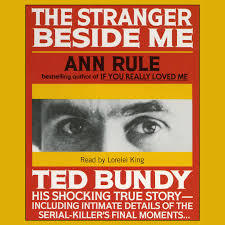 The Stranger Beside Me by Ann Rulepsychopaths.
The Stranger Beside Me by Ann Rulepsychopaths.
My interest is, thank god, an academic one, a writer's curiosity about the extremes of human behaviour. My friend, poor woman, married a psychopath and has first hand experience of the dedicated selfishness that a human being can be capable of, the blind inability to appreciate that anyone except them has any right to an opinion, a life or free will.
But when it comes to psycho-spotting, author and journalist Ann Rule can perhaps claim the prize.
As a journalist, she often handled crime reports, spent a lot of time in police stations talking to detectives and made several friends on the force.
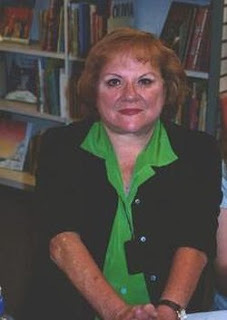 Ann Rule, from her Amazon page In her 40s, she volunteered to man phones on a suicide help-line, and shared her regular night-shift with a psychology student named Ted. She thought him a lovely young man and they became good friends, despite the age-gap of ten years. He was so caring towards the callers and at the end of her shift, he always walked her to her car, to make sure she was safe - whereas her detective friends, when she left their offices late at night, would say, "We'll watch from the window and if anyone mugs you, we'll phone 911."
Ann Rule, from her Amazon page In her 40s, she volunteered to man phones on a suicide help-line, and shared her regular night-shift with a psychology student named Ted. She thought him a lovely young man and they became good friends, despite the age-gap of ten years. He was so caring towards the callers and at the end of her shift, he always walked her to her car, to make sure she was safe - whereas her detective friends, when she left their offices late at night, would say, "We'll watch from the window and if anyone mugs you, we'll phone 911."
This little anecdote perhaps highlights something about psychopaths (and human nature.) Rule's detective friends were showing genuine concern and covering it with a joke. They probably knew there was little risk to her and, as ordinary human beings with many other concerns, they said goodbye and got on with their lives and jobs.
'Ted', on the other hand, was acting a role, performing the character of 'lovely young man and caring friend.' It was convincing so long as it was never tested. One difference between someone telling the truth and a liar is that the truth-teller has 'an expectation of belief' because they know that they're telling the truth and therefore don't think they need bother to be meticulously convincing. They give a rough account, forget details - or assume that their genuine affection is apparent and needs no display.
Liars know themselves to be lying and therefore go several extra miles in order to convince. Their stories are neatly in order, with lots of irrelevant detail to 'hide the lie among truths.' When it comes to relationships, their false affection is constantly voiced, rehearsed and displayed. And takes many in. Alas, research has shown that, though most of us think we can tell when someone is lying, we're actually very bad at it.
Rule was no longer working with Ted, but was still in touch Seattle, wikimediawith him, when young women started disappearing from the Greater Seattle area. Rule was soon aware, from her friends in the Police, that they feared they were dealing with a serial killer. When suspicion fell on Ann Rule's friend, Ted, she thought it was obviously a routine enquiry or a mistake...
Seattle, wikimediawith him, when young women started disappearing from the Greater Seattle area. Rule was soon aware, from her friends in the Police, that they feared they were dealing with a serial killer. When suspicion fell on Ann Rule's friend, Ted, she thought it was obviously a routine enquiry or a mistake...
But it wasn't. Ann's friend was Ted Bundy, and she found herself in the middle of the crime story that would define her career. For ever after she would be, the woman who worked beside Ted Bundy.
Bundy abducted, terrified, raped and murdered many women, possibly more than a hundred. Like most serial killers, he probably started much earlier than the crimes he was charged with. Rule's research turned up the fact that, when Bundy was 15, a young girl, a child, was abducted from her home and murdered. The killer was never found. Bundy lived a few doors away, and knew the child. He never admitted to that killing - but he never admitted to anything unless there was an advantage for him.
He was eventually arrested in Seattle, but insisted on representing himself, which gave him the right to make trips to the library to look at law books. While swearing complete innocence and mistaken arrest, he used a library trip to escape.
He ran to Florida, but couldn't give up his hobby. Or was killing his addiction, his crutch? Within a week of arriving in Florida, he attacked several women in one night, killing three and leaving other badly injured.
 Florida Capitol, wikimedia Bundy found Florida less careless and forgiving than the North-West. They sentenced him to death and placed him in a far more secure prison. Another escape attempt was thwarted and after that he was kept in chains. Yes, he could have his trips to the law library - in chains.
Florida Capitol, wikimedia Bundy found Florida less careless and forgiving than the North-West. They sentenced him to death and placed him in a far more secure prison. Another escape attempt was thwarted and after that he was kept in chains. Yes, he could have his trips to the law library - in chains.
Now you would think that, to him, life was cheap. He had, after all, killed an unknown number of women for fun. Their lives and everything and everyone their lives had encompassed, had been as disposable, to him, as a condom. So what was a little matter of a death sentence, when life is so unimportant?
But only other people's lives were unimportant to Bundy. He tried every possible delaying tactic, trick and appeal to preserve his own life. He also attempted to use the names of the women he'd murdered, and the sites where he'd dumped their bodies, as bargaining tools. Grant him another appeal, let him live a little longer, and he might give up a few more identities and a few more remains for burial.
Bundy was an exemplary serial killer in that he demonstrates just how loathsome a nasty piece of work a human being can be - and yet he had a little fan club of female fools who were besotted with him. One even married him and had his child.
If the psychology of serial killers is strange, the psychology of their groupies defeats me.
If you share my interest in the minds of psychopaths, then Rule's book is of great interest. It sprawls a little, because she has updated it regularly over more than twenty years.
Besides knowing the loathsome Bundy personally, and having access to him in jail, she has also interviewed many of the people he bereaved, which throws up some intriguing stories.
The husband of one murdered woman was away on business on the day she was abducted. He told Rule that, in his distant hotel room, late on that day, he clearly heard his wife's voice say, "Help."
Bundy's final killing spree took place in a university dormitory. He broke in, and lay in wait in darkened corridors. Rule interviewed a couple of survivors who survived because, as they told Rule, they became seized by what seemed, at the time, an inexplicable fear. One girl was in a bathroom and only had to step across the dark corridor to her bedroom, but found herself completely unable, for fear, to open the door. She had no idea why. She had no idea, consciously at least, that Bundy was murdering her fellow students a little way down the corridor.
The Stranger Beside Me is often a grim read, but it's an informative one.
 The Stranger Beside Me by Ann Rulepsychopaths.
The Stranger Beside Me by Ann Rulepsychopaths.My interest is, thank god, an academic one, a writer's curiosity about the extremes of human behaviour. My friend, poor woman, married a psychopath and has first hand experience of the dedicated selfishness that a human being can be capable of, the blind inability to appreciate that anyone except them has any right to an opinion, a life or free will.
But when it comes to psycho-spotting, author and journalist Ann Rule can perhaps claim the prize.
As a journalist, she often handled crime reports, spent a lot of time in police stations talking to detectives and made several friends on the force.
 Ann Rule, from her Amazon page In her 40s, she volunteered to man phones on a suicide help-line, and shared her regular night-shift with a psychology student named Ted. She thought him a lovely young man and they became good friends, despite the age-gap of ten years. He was so caring towards the callers and at the end of her shift, he always walked her to her car, to make sure she was safe - whereas her detective friends, when she left their offices late at night, would say, "We'll watch from the window and if anyone mugs you, we'll phone 911."
Ann Rule, from her Amazon page In her 40s, she volunteered to man phones on a suicide help-line, and shared her regular night-shift with a psychology student named Ted. She thought him a lovely young man and they became good friends, despite the age-gap of ten years. He was so caring towards the callers and at the end of her shift, he always walked her to her car, to make sure she was safe - whereas her detective friends, when she left their offices late at night, would say, "We'll watch from the window and if anyone mugs you, we'll phone 911."This little anecdote perhaps highlights something about psychopaths (and human nature.) Rule's detective friends were showing genuine concern and covering it with a joke. They probably knew there was little risk to her and, as ordinary human beings with many other concerns, they said goodbye and got on with their lives and jobs.
'Ted', on the other hand, was acting a role, performing the character of 'lovely young man and caring friend.' It was convincing so long as it was never tested. One difference between someone telling the truth and a liar is that the truth-teller has 'an expectation of belief' because they know that they're telling the truth and therefore don't think they need bother to be meticulously convincing. They give a rough account, forget details - or assume that their genuine affection is apparent and needs no display.
Liars know themselves to be lying and therefore go several extra miles in order to convince. Their stories are neatly in order, with lots of irrelevant detail to 'hide the lie among truths.' When it comes to relationships, their false affection is constantly voiced, rehearsed and displayed. And takes many in. Alas, research has shown that, though most of us think we can tell when someone is lying, we're actually very bad at it.
Rule was no longer working with Ted, but was still in touch
 Seattle, wikimediawith him, when young women started disappearing from the Greater Seattle area. Rule was soon aware, from her friends in the Police, that they feared they were dealing with a serial killer. When suspicion fell on Ann Rule's friend, Ted, she thought it was obviously a routine enquiry or a mistake...
Seattle, wikimediawith him, when young women started disappearing from the Greater Seattle area. Rule was soon aware, from her friends in the Police, that they feared they were dealing with a serial killer. When suspicion fell on Ann Rule's friend, Ted, she thought it was obviously a routine enquiry or a mistake...But it wasn't. Ann's friend was Ted Bundy, and she found herself in the middle of the crime story that would define her career. For ever after she would be, the woman who worked beside Ted Bundy.
Bundy abducted, terrified, raped and murdered many women, possibly more than a hundred. Like most serial killers, he probably started much earlier than the crimes he was charged with. Rule's research turned up the fact that, when Bundy was 15, a young girl, a child, was abducted from her home and murdered. The killer was never found. Bundy lived a few doors away, and knew the child. He never admitted to that killing - but he never admitted to anything unless there was an advantage for him.
He was eventually arrested in Seattle, but insisted on representing himself, which gave him the right to make trips to the library to look at law books. While swearing complete innocence and mistaken arrest, he used a library trip to escape.
He ran to Florida, but couldn't give up his hobby. Or was killing his addiction, his crutch? Within a week of arriving in Florida, he attacked several women in one night, killing three and leaving other badly injured.
 Florida Capitol, wikimedia Bundy found Florida less careless and forgiving than the North-West. They sentenced him to death and placed him in a far more secure prison. Another escape attempt was thwarted and after that he was kept in chains. Yes, he could have his trips to the law library - in chains.
Florida Capitol, wikimedia Bundy found Florida less careless and forgiving than the North-West. They sentenced him to death and placed him in a far more secure prison. Another escape attempt was thwarted and after that he was kept in chains. Yes, he could have his trips to the law library - in chains.Now you would think that, to him, life was cheap. He had, after all, killed an unknown number of women for fun. Their lives and everything and everyone their lives had encompassed, had been as disposable, to him, as a condom. So what was a little matter of a death sentence, when life is so unimportant?
But only other people's lives were unimportant to Bundy. He tried every possible delaying tactic, trick and appeal to preserve his own life. He also attempted to use the names of the women he'd murdered, and the sites where he'd dumped their bodies, as bargaining tools. Grant him another appeal, let him live a little longer, and he might give up a few more identities and a few more remains for burial.
Bundy was an exemplary serial killer in that he demonstrates just how loathsome a nasty piece of work a human being can be - and yet he had a little fan club of female fools who were besotted with him. One even married him and had his child.
If the psychology of serial killers is strange, the psychology of their groupies defeats me.
If you share my interest in the minds of psychopaths, then Rule's book is of great interest. It sprawls a little, because she has updated it regularly over more than twenty years.
Besides knowing the loathsome Bundy personally, and having access to him in jail, she has also interviewed many of the people he bereaved, which throws up some intriguing stories.
The husband of one murdered woman was away on business on the day she was abducted. He told Rule that, in his distant hotel room, late on that day, he clearly heard his wife's voice say, "Help."
Bundy's final killing spree took place in a university dormitory. He broke in, and lay in wait in darkened corridors. Rule interviewed a couple of survivors who survived because, as they told Rule, they became seized by what seemed, at the time, an inexplicable fear. One girl was in a bathroom and only had to step across the dark corridor to her bedroom, but found herself completely unable, for fear, to open the door. She had no idea why. She had no idea, consciously at least, that Bundy was murdering her fellow students a little way down the corridor.
The Stranger Beside Me is often a grim read, but it's an informative one.
Published on February 12, 2016 16:00
January 15, 2016
Take The 'Mary Sue' Test
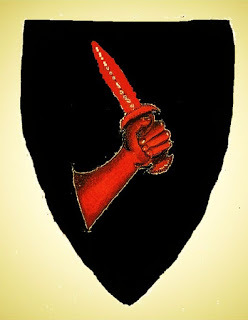 Hello all.
Hello all.I'm trying to complete the rewrite of Sterkarm Tryst, and I've had to ask for an extension on the deadline. I now have until February 2nd.
I'm enjoying the rewrite, as I always do - but I've got to get the head down, no messing about.
So, instead of a new blog, here's something I came across...The Mary Sue Test.
I found the link to it in the Kindle edition of the book, Medieval Underpants and Other Blunders, by Susanne Alleyn - a sort of aid to writers of historical fiction, which is as amusing as it is informative.
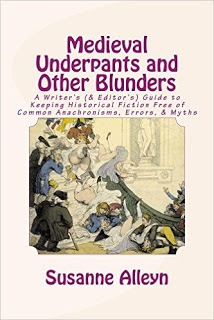 Medieval Underpants - Alleyn
Medieval Underpants - AlleynWhat's a 'Mary Sue?'
Well, to quote Wikipedia (which Susanne Alleyn, I'm glad to say, tells us is 'our friend'):
The term "Mary Sue" comes from the name of a character created by Paula Smith in 1973 for her parody story "A Trekkie's Tale"[ published in her fanzine Menagerie #2. The story starred Lieutenant Mary Sue ("the youngest Lieutenant in the fleet — only fifteen and a half years old"), and satirized unrealistic Star Trek fan fiction. Such characters were generally female adolescents who had romantic liaisons with established canonical adult characters, or in some cases were the younger relatives or protégées of those characters. By 1976 Menagerie's editors stated that they disliked such characters, saying:Mary Sue stories—the adventures of the youngest and smartest ever person to graduate from the academy and ever get a commission at such a tender age. Usually characterized by unprecedented skill in everything from art to zoology, including karate and arm-wrestling. This character can also be found burrowing her way into the good graces/heart/mind of one of the Big Three [Kirk, Spock, and McCoy], if not all three at once. She saves the day by her wit and ability, and, if we are lucky, has the good grace to die at the end, being grieved by the entire ship."Mary Sue" today has changed from its original meaning and now carries a generalized, although not universal, connotation of wish-fulfillment and is commonly associated with self-insertion. True self-insertion is a literal and generally undisguised representation of the author; most characters described as "Mary Sues" are not, though they are often called "proxies" for the author. The negative connotation comes from this "wish-fulfillment" implication: the "Mary Sue" is judged as a poorly developed character, too perfect and lacking in realism to be interesting.Mr. Spock
Although, originally, the term applied exclusively to Sci-Fi and Fantasy characters, Alleyn warns writers of historical fantasy against Mary-Sue-ism. For instance, don't create a female character who lives in Tudor England but is really a poorly disguised expression of the author's wish to wear a fab-u-lous dress-up costume, without engaging with the reality of women's lives in the 16th Century. A character who is, in every way, except for her clothes, a 21st Century product of Western culture.
The Mary-Sue test itself is here -
http://katfeete.net/writing/sue.php
I've amused myself in odd moments by running a few of my characters through it - including Per and Andrea from the Sterkarm novels - and am relieved to report that neither came out as Mary-Sues. (And I was honest, honest!)
Published on January 15, 2016 16:00
January 1, 2016
The Whisky Differential
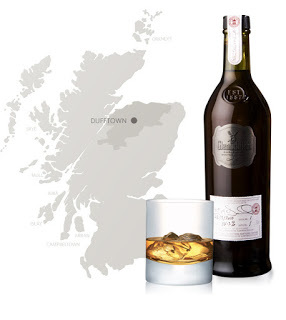 From Glenfiddich websiteWell, it pays to advertise!
From Glenfiddich websiteWell, it pays to advertise!I swear, when I ended my last post with a plea for a supply of whisky, it was a joke, and not meant to influence Christmas presents - but I can't honestly say I'm sorry that it did.
My lovely Scot usually buys me a bottle of whisky for Christmas, and he came through, as always, this year, with a bottle of Aberlour.
My older brother (the one who does my indie covers) always complains that he never knows what to buy me - and that I'm no help when I say, 'Nothing. Or maybe a tobelerone.' Well, this year, he bought me a bottle of Glenfiddich.
And my younger brother and his lovely wife bought me a bottle of - yes - Laphroig. Whether this means they read my blog or whether there was just a certain amount of fraternal discussion, I don't know.
Anyroad up, Shucks, this puts me in the happy position of being able to make direct comparisons between three single malts. Believe me, this is a blog I am going to enjoy writing.
I can't claim any expertise, or a refined palate. I just like
 The red circle shows (very roughly) the Speyside areasingle malt whisky
The red circle shows (very roughly) the Speyside areasingle malt whisky Monday
Glenfiddich. The distillery is in Speyside, up in the Highlands. and it's still independent. The nearest big town is Inverness. The name means 'Valley of the Deer.'
I haven't drunk a glass of Glenfiddich for many a long year and remember it, and Glenlivit, as being pale and lemony.
So the first surprise is that it's much richer and more golden in colour than I remember. The scent was different from my memories too: richer and, while fruity, not citrus or lemony at all. I sniffed it for a while, trying to place the scent - until I read the label and it claimed 'pear' as the fruit it resembled. And yes, though I'm wary of being influenced by advertising, I can go with that. There's that round, sweet, juicy pear-drops smell.
So I took a sip - and it's very sweet. And very warming. I don't find the lemon flavour I remember at all. Complete memory fail there. Instead, it's all honey - with just a little hint of fire as it goes over the tonsils. (I gave the older brother a nip. He claims not to like whisky at all - but he certainly took to the sweetness of Glenfiddich.)
The distillery claims it has earned the highest awards of any single malt, and I can understand why it would be popular. I don't mean that as a put-down, either. I mean, simply, that it's honey-sweet and warming, slips down like a bedtime drink, and is delicious. Why wouldn't a lot of people like it?
Tuesday.
Aberlour. Another Speyside malt, made beside the river Lour. It's pronounced 'Abba-LOW-er, and the name means 'Mouth of the Chattering Burn.' Or so it says on the website. If you want to see beautiful photographs, combined with loads of old tosh about druids and ancient traditions invented last week in an advertising agency, I recommend the websites of single malt whisky distilleries. But that's by the by. I'm here to drink whisky.
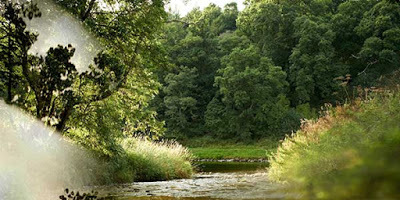 From the Aberlour website When poured into the glass, Aberlour is a much deeper gold than Glenfiddich, an autumnal orange. My first sniff immediately made me think of fruit-cake. There is that spicy fruitiness.
From the Aberlour website When poured into the glass, Aberlour is a much deeper gold than Glenfiddich, an autumnal orange. My first sniff immediately made me think of fruit-cake. There is that spicy fruitiness.Despite smelling like cake, the taste is much less sweet than Glenfiddich, though just as warming. There is a rather citrus taste to this one, like candied peel in a fruit cake. And that smell... What is the most predominate smell of fruit-cake? Warm, slightly burnt sugar perhaps? Butteriness? Raisins? Nutmeg?
Then, when you swallow, there's a slight bite, a little heat, but nothing harsh. The warmth stays with you. It's delicious.
Wednesday
Laphroaig . The famous Laphroaig - which I realise I've been misspelling. Here's Brian Cox, showing how to pronounce it.
It comes from the opposite side of Scotland to the other two - from Islay in the Hebrides. Their advertising company isn't as keen to find a romantic sounding translation of the name, but manage to suggest that it derives from the Norse for 'broad bay.' They boast about being 200 years old and put film of Charlie Windsor - in a kilt yet - on their website. Honestly, if I didn't like malt whisky so much...
But the whisky. When poured from the bottle it's much
 darker than the others, almost the deep orange-brown of tea. And the smell is very different. Seaweed and smoke - it's always referred to as 'peat-smoke' but reminds me of the scent of woodsmoke from bonfires on the beach. There's still a little bit of that nutmeg, spice and honey.
darker than the others, almost the deep orange-brown of tea. And the smell is very different. Seaweed and smoke - it's always referred to as 'peat-smoke' but reminds me of the scent of woodsmoke from bonfires on the beach. There's still a little bit of that nutmeg, spice and honey.The longer you hold the glass to your nose and sniff, the more the smell of smoke fades and the honey comes through. Something of chocolate and something of flowers.
When you taste it - there's almost too much going on for an amateur like me. It's less sweet again, and that slightly bitter, smoky bite hangs around warmly at the back of your throat for quite a while, as with ginger or chili in a curry. I suppose that's what the tasters call 'the long finish.'
I suddenly realised what an element of the taste and smell reminds me of - tar! The hot tar that used to be spread on the roads when I was a child, and which we would go and sniff.
Laphroaig has a whole section of its website dedicated to fans' descriptions of its flavour. 'Deck shoes' and 'sailors' socks' seems to feature quite a lot - and tar. Tar and honey.
And ashes, I would say. And earth.
It's delicious.
Thank you to all the lovely people - take a bow, Patti and Adam, Davy and Andrew - who bought me a bottle of single malt. And all different! It has been a real pleasure, trying them in turn like this and comparing them.
Conclusions? - I love them all! It's been great getting reacquainted with Glenfiddich, which I had unfairly come to think of as rather bland. It is a very approachable and friendly single malt, but so sweet and warm and delicious, how can you not love it?
Aberlour has been a favourite for a while - it's like drinking fruit-cake, so how can you not love that?
Laphroaig is the scary, peaty one, with the difficult name and the smell of kippers and rubber. The brother recoiled from the glass when I offered him a nip. "Too much for me," he said - but, y'know, once you get to know it, it drops the hard-man act and you find the honey.
I really couldn't choose a favourite - and I'm going to have a difficult decision to make with every dram over the next few months. Which bottle?
I raise to you the parting-glass...
Goodbye! - And a happy 2016 to you all!
Published on January 01, 2016 16:00
December 4, 2015
A Spiritual Revelation: Single Malt Whisky
 Comedian Rich HallI once saw the comedian Rich Hall addressing an audience. He asked if there were any Scottish people in. Answering roars told him that some people came from Edinburgh
Comedian Rich HallI once saw the comedian Rich Hall addressing an audience. He asked if there were any Scottish people in. Answering roars told him that some people came from Edinburgh"Ah, Edinburgh," he said. "I once had a spiritual revelation in Edinburgh. It was called, 'Single Malt Whisky.'"
I feel much the same, though my spirituous revelation didn't happen anywhere in Scotland - and it happened well before I met my Scottish partner. I was already a faithful drinker of single malts by the time I met the Scot.
It was another man who, one evening, asked me what I was drinking. "Whisky." I said, and his interest was piqued. Which whisky did I favour? - and he reeled off a few of the single malts.
"Oh, just get me a whisky," I said, in my ignorance. "Doesn't matter which one - I don't believe in all that marketing hype about single malts."
He was offended. It was not mere marketing hype, he said. A single malt was vastly superior to the cheap, blended stuff. It was made in the place it was named after, from local water and grain. It was lovingly aged - and ya-da-yah, as I thought then, he spouted all the marketing rubbish about sherry and oak casks.
"It's just branding," I said. "It's just an excuse to charge more."
Allow him, he said, to do me a kindness and prove me wrong. Allow him, if I would, to buy me a couple of different single malts. Taste them, and then tell him that there was no difference between them and the likes of Jack Daniels, Bell and Johnnie Walker.
Well, okay, I said, if you're paying.
I always liked whisky best, of all spirits, ever since I used to sip from older relatives' glasses as a child. But whenever I drank it, the harshness of the alcohol made me shudder to my toes. That was the price, I thought, of liking whisky. You had to put up with the shudder.
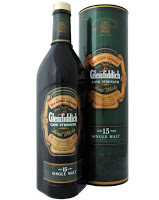 I can't remember which whiskys the gentleman bought me. Since he knew he was dealing with a beginner, it was probably a couple of the softer ones. Maybe a Glenfiddich or a Glenlivit for one - they are light, pale yellow and have a lemony, citrusy taste. And perhaps a richer, fruit-cakey one, aged in sherry-casks, such as an Aberlour.
I can't remember which whiskys the gentleman bought me. Since he knew he was dealing with a beginner, it was probably a couple of the softer ones. Maybe a Glenfiddich or a Glenlivit for one - they are light, pale yellow and have a lemony, citrusy taste. And perhaps a richer, fruit-cakey one, aged in sherry-casks, such as an Aberlour.And it was a spiritual revelation. I drank and I didn't shudder. I realised what 'smooth' means, when applied to spirit. The single malts were so well made and aged that they slipped down with nothing more than a warm glow - and a wealth of flavours.
Once you're converted, there are so many to try! Jura, Auchentosh, Glenmorangie, Talisker, Dalwhinnie, Craganmore...
All of them a little different. When I did meet the Scot, he told me that his father had been a whisky cooper, and in the course of cooping barrels for many different distilleries, had sampled many, many different whiskys. It was his experienced and considered opinion that the best of them all was a 10-year old Macallan. It didn't, to his taste, improve for being 12, 15 or 30 years old. The ten year old Mac: that was the one.
And it is excellent - as is Bushmills Irish single malt, though the Scots of my acquaintance frown on Irish whiskys (and, for that matter, American and Japanese 'whiskys.' If it's not from Scotland, it's not whisky, is their thinking.)
Personally, though, after years of trying different single malts, I'm coming to the conclusion that the best of the lot is, as many agree, Islay's Laphroig. (It's pronounced 'La-FROYg.)

Scots friends have put forward Lagvulan as their favourite. It's very good - I've yet to meet a single malt I didn't like - but good as it is, it's not Laphroig.
I didn't think so when I first tasted Laphroig, years ago. I thought it smelled and tasted like burning rubber or kippers. I much preferred the lighter malts, like Glenfiddich or Oban. Or Highland Park from the Orkneys.
But, gradually, I learned to like it. Peat smoke and honey is one of those poetic tasting descriptions for Laphroig, and the last time I drank some, I could appreciate what that meant. I could taste the sweeter honey notes coming through the harshness of smoke and iodine. I had another spiritual revelation: I realised I loved Laphroig.
Still, it doesn't matter: mild Glenfiddich or smoky Laphroig, or spicy Aberlour, or any of the others, there is no spirit that has so much warmth and so many layers and variations in flavour as single malt whisky. I love the stuff.
I tried to repay the gent who convinced me of the worth of single malt a few months ago. I was passing the shelf of whisky in a well known supermarket, and saw a lady looking confused in front of them. So I went over to check out my next purchase (single malts are my only extravagance) and asked her which one she fancied herself.
She told me she knew nothing about whisky, but had been charged by her friends with the task of buying a bottle for their retiring manager - who it seemed they all liked. He was a whisky drinker, she said, so they thought a bottle of - and she waved vaguely towards the blends. But now she was here, there were so many different kinds and she was confused.
Buy him a single malt, I said. If he's a whisky drinker, he'll be grateful. I think I steered her to an Oban in the end - a little bit smoky, but with a spicy, citrus sweetness too.
This blog comes to you with the faint, but very real hope, that a whisky distillery will be overcome with Christmas good cheer and grant me a lifetime's supply of single malt.
Or even a single bottle. Go on.
Just one.
Go on, go on.
Published on December 04, 2015 16:00
November 27, 2015
A Book's Colouring
At the moment I'm working on three books at the same time. I've always worked on two or more books at once.
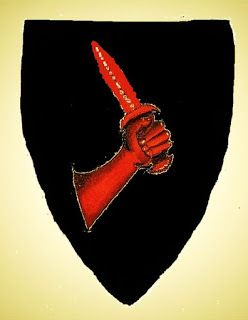 I've always been aware that each book develops its own atmosphere and colouring - and that as I move from one book to another, the mental 'weather' can change drastically. But, while being aware of it, it's never been something that I've thought about very clearly, or tried to pin down, until now.
I've always been aware that each book develops its own atmosphere and colouring - and that as I move from one book to another, the mental 'weather' can change drastically. But, while being aware of it, it's never been something that I've thought about very clearly, or tried to pin down, until now.
The Sterkarms, for instance. The colouring of the Sterkarm books is red and black, like their badge - and the colouring came first, before I decided on the badge. When I think of the books, or the work I have to do on the third book, this is what pulls together all the disparate characters, plot-lines, scene-settings and so on - the glowering red and black colouring.
For me, the Sterkarm books are dark, low rooms, half filled with peat smoke. A glimmer of red firelight flickers on the underside of the grey smoke. Embers glower redly.
The Sterkarm books have many scenes which take place outside, but in my mind, in this overall impression, the days are overcast, the sky thick and grey with cloud. The greens of the hillsides are dark, the bracken russet - all the colours tilt towards their darker shades.
But then, if I move to the other book I'm working on, Follow The Dogs, there's a big, instant change. The book is set is Scotland, as are the Sterkarm books - it's about a boy following herd dogs across Scotland, from Fife in the East, to the Isle of Mull in the West. He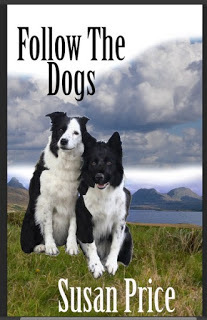 Follow The Dogs by Susan Pricedescribes sheltering from bad weather, and grey, wet days - yet in my head, this book is fresh and bright. The hills are a brighter green, the sky blue. A fresh, cool wind blows through it. For me, the book is full of air and space - the view from the hills above Oban, across the sea to the Hebrides, with the water blazing like polished silver.
Follow The Dogs by Susan Pricedescribes sheltering from bad weather, and grey, wet days - yet in my head, this book is fresh and bright. The hills are a brighter green, the sky blue. A fresh, cool wind blows through it. For me, the book is full of air and space - the view from the hills above Oban, across the sea to the Hebrides, with the water blazing like polished silver.
And take a third book. I've been dressing up my Story Collector, which is a series of folk-tales, told in the 'frame' of an elderly gentleman in the 19th Century. Mr. Grimsby, a retired manufacturer, collects stories from his maidservant, her grandmother, an old soldier, and others.
When I think of this 'frame', I see polished brown leather, brass and firelight. I smell the gas-lights that burned in the house I was born in, and coal burning in a grate.
But if I think of the stories told within the frames, I 'see' something altogether lighter - in fact, something very like the silhouettes I've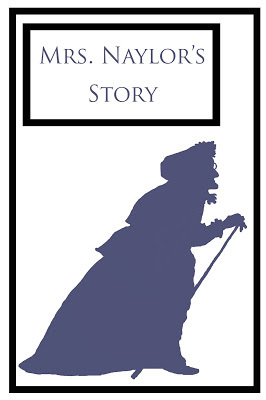 Art work: Andrew Pricebeen creating (with a lot of help from my brother) for the title page of each story. They remind me, a little, of the blue and white tiles used to decorate stoves and fireplaces.
Art work: Andrew Pricebeen creating (with a lot of help from my brother) for the title page of each story. They remind me, a little, of the blue and white tiles used to decorate stoves and fireplaces.
I'm not sure if I'm explaining it clearly, but the impressions I describe above are nothing to do with the descriptions of the scenes within each book. Instead, they are a sort of handle by which I can grab everything to do with a particular story and bring it together so I can enter it.
I mentioned it to my brother, and he immediately understood what I meant. He said it exists for paintings too. Before a painting exists, he said, while it's still only an idea in his mind, it has an atmosphere, a colouring, by which he can 'hold' it. Then, since he usually sketches first, before adding colour, he has to find the lines that form it. But even after he's found those lines, and what was once just an idea is firmly drawn - the picture still retains that mental colouring and atmosphere.
I'm curious to know if others recognise this. Do your books, your poems, your paintings each have their own unique colouring and atmosphere, which sum them up in your mind?
 I've always been aware that each book develops its own atmosphere and colouring - and that as I move from one book to another, the mental 'weather' can change drastically. But, while being aware of it, it's never been something that I've thought about very clearly, or tried to pin down, until now.
I've always been aware that each book develops its own atmosphere and colouring - and that as I move from one book to another, the mental 'weather' can change drastically. But, while being aware of it, it's never been something that I've thought about very clearly, or tried to pin down, until now. The Sterkarms, for instance. The colouring of the Sterkarm books is red and black, like their badge - and the colouring came first, before I decided on the badge. When I think of the books, or the work I have to do on the third book, this is what pulls together all the disparate characters, plot-lines, scene-settings and so on - the glowering red and black colouring.
For me, the Sterkarm books are dark, low rooms, half filled with peat smoke. A glimmer of red firelight flickers on the underside of the grey smoke. Embers glower redly.
The Sterkarm books have many scenes which take place outside, but in my mind, in this overall impression, the days are overcast, the sky thick and grey with cloud. The greens of the hillsides are dark, the bracken russet - all the colours tilt towards their darker shades.
But then, if I move to the other book I'm working on, Follow The Dogs, there's a big, instant change. The book is set is Scotland, as are the Sterkarm books - it's about a boy following herd dogs across Scotland, from Fife in the East, to the Isle of Mull in the West. He
 Follow The Dogs by Susan Pricedescribes sheltering from bad weather, and grey, wet days - yet in my head, this book is fresh and bright. The hills are a brighter green, the sky blue. A fresh, cool wind blows through it. For me, the book is full of air and space - the view from the hills above Oban, across the sea to the Hebrides, with the water blazing like polished silver.
Follow The Dogs by Susan Pricedescribes sheltering from bad weather, and grey, wet days - yet in my head, this book is fresh and bright. The hills are a brighter green, the sky blue. A fresh, cool wind blows through it. For me, the book is full of air and space - the view from the hills above Oban, across the sea to the Hebrides, with the water blazing like polished silver.And take a third book. I've been dressing up my Story Collector, which is a series of folk-tales, told in the 'frame' of an elderly gentleman in the 19th Century. Mr. Grimsby, a retired manufacturer, collects stories from his maidservant, her grandmother, an old soldier, and others.
When I think of this 'frame', I see polished brown leather, brass and firelight. I smell the gas-lights that burned in the house I was born in, and coal burning in a grate.
But if I think of the stories told within the frames, I 'see' something altogether lighter - in fact, something very like the silhouettes I've
 Art work: Andrew Pricebeen creating (with a lot of help from my brother) for the title page of each story. They remind me, a little, of the blue and white tiles used to decorate stoves and fireplaces.
Art work: Andrew Pricebeen creating (with a lot of help from my brother) for the title page of each story. They remind me, a little, of the blue and white tiles used to decorate stoves and fireplaces.I'm not sure if I'm explaining it clearly, but the impressions I describe above are nothing to do with the descriptions of the scenes within each book. Instead, they are a sort of handle by which I can grab everything to do with a particular story and bring it together so I can enter it.
I mentioned it to my brother, and he immediately understood what I meant. He said it exists for paintings too. Before a painting exists, he said, while it's still only an idea in his mind, it has an atmosphere, a colouring, by which he can 'hold' it. Then, since he usually sketches first, before adding colour, he has to find the lines that form it. But even after he's found those lines, and what was once just an idea is firmly drawn - the picture still retains that mental colouring and atmosphere.
I'm curious to know if others recognise this. Do your books, your poems, your paintings each have their own unique colouring and atmosphere, which sum them up in your mind?
Published on November 27, 2015 16:00
November 13, 2015
The Latest News On Sterkarm 3 Is...
Did I already mention that the new Sterkarm book is going to be
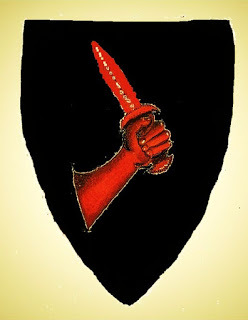 Come who dares and meddle with uscalled 'A Sterkarm Tryst?'
Come who dares and meddle with uscalled 'A Sterkarm Tryst?'
It's all official now: the editor agrees - is even referring to it as 'Tryst' in emails now.
I never was happy with its working title 'Sterkarm Embrace.' It always seemed a bit awkward and, well, just wrong.
I was trying to come up with alternatives when my partner, Davy, suggested 'Tryst.' The more I thought about it, the more right it seemed. And Davy is chuffed because he so often complains that I don't listen to him. "At least you listened to 'Tryst,'" he said, the other day. The book is certain to be a huge success, of course, because I listened to him and called it 'Tryst' instead of anything else.
I suppose, these days, we mostly think of 'Tryst' as an archaic, romantic word, referring to star-crossed lovers stealing away to meet under the moon. My always-within-reach OED defines it as 'a private, romantic rendezvous between lovers,' but adds that it derives from the Middle English, through French and Latin. Originally, as triste or trista, it meant 'an appointed meeting place in hunting.'
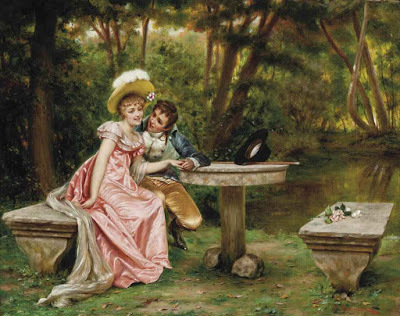 by Soulacroix - a very un-Sterkarm tryst.
by Soulacroix - a very un-Sterkarm tryst.
Davy, being Scots, has another take on it. He's been interested in the research for my story Follow The Dogs, which tells of the Scottish drovers, and the great cattle markets held at Falkirk. These great meetings of drovers and cattle-dealers were known as 'trysts.'
So the word 'tryst' covers romance and, generally, meeting places.
The other two books, A Sterkarm Handshake and A Sterkarm Kiss have double meanings which belie their friendly sound. (That's a Sterkarm handshake, at the top of this blog.) So what's the double-meaning of a Sterkarm tryst?
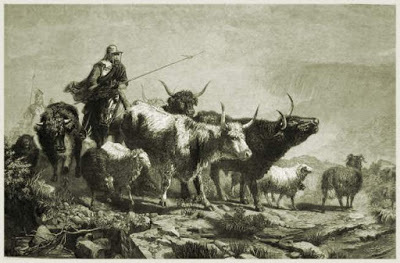 Well, the Border reivers were especially fond of laying ambushes. They would drive off cattle, and lay an ambush for the pursuers. They were guerilla fighters before the term was invented, making the most of suprise attacks and then fading away into their wild countryside. So, a Sterkarm Tryst is an ambush - a meeting place appointed by only one side.
Well, the Border reivers were especially fond of laying ambushes. They would drive off cattle, and lay an ambush for the pursuers. They were guerilla fighters before the term was invented, making the most of suprise attacks and then fading away into their wild countryside. So, a Sterkarm Tryst is an ambush - a meeting place appointed by only one side.
But there's a hint of romance about the word, too, to bring in Andrea and Per. And a strong whiff of cattle, which there always would be around the Sterkarms.
Other people may not like it, but I'm happy with A Sterkarm Tryst. Finally.
I've been given a deadline for the books now. Open Road want the manuscript of Tryst in for copy-editing by mid-January. And any changes I want made to the other two books by mid-March. I can only say: Aaargh! Thank the lord I don't have any school visits or talks booked for December. I may cancel Christmas.
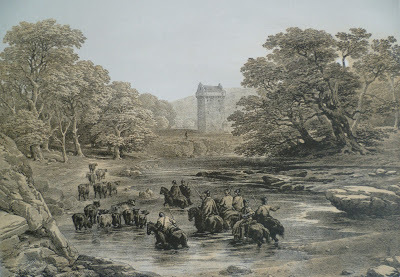
You can take a look at my other books here, on my website.
 Come who dares and meddle with uscalled 'A Sterkarm Tryst?'
Come who dares and meddle with uscalled 'A Sterkarm Tryst?'It's all official now: the editor agrees - is even referring to it as 'Tryst' in emails now.
I never was happy with its working title 'Sterkarm Embrace.' It always seemed a bit awkward and, well, just wrong.
I was trying to come up with alternatives when my partner, Davy, suggested 'Tryst.' The more I thought about it, the more right it seemed. And Davy is chuffed because he so often complains that I don't listen to him. "At least you listened to 'Tryst,'" he said, the other day. The book is certain to be a huge success, of course, because I listened to him and called it 'Tryst' instead of anything else.
I suppose, these days, we mostly think of 'Tryst' as an archaic, romantic word, referring to star-crossed lovers stealing away to meet under the moon. My always-within-reach OED defines it as 'a private, romantic rendezvous between lovers,' but adds that it derives from the Middle English, through French and Latin. Originally, as triste or trista, it meant 'an appointed meeting place in hunting.'
 by Soulacroix - a very un-Sterkarm tryst.
by Soulacroix - a very un-Sterkarm tryst.Davy, being Scots, has another take on it. He's been interested in the research for my story Follow The Dogs, which tells of the Scottish drovers, and the great cattle markets held at Falkirk. These great meetings of drovers and cattle-dealers were known as 'trysts.'
So the word 'tryst' covers romance and, generally, meeting places.
The other two books, A Sterkarm Handshake and A Sterkarm Kiss have double meanings which belie their friendly sound. (That's a Sterkarm handshake, at the top of this blog.) So what's the double-meaning of a Sterkarm tryst?
 Well, the Border reivers were especially fond of laying ambushes. They would drive off cattle, and lay an ambush for the pursuers. They were guerilla fighters before the term was invented, making the most of suprise attacks and then fading away into their wild countryside. So, a Sterkarm Tryst is an ambush - a meeting place appointed by only one side.
Well, the Border reivers were especially fond of laying ambushes. They would drive off cattle, and lay an ambush for the pursuers. They were guerilla fighters before the term was invented, making the most of suprise attacks and then fading away into their wild countryside. So, a Sterkarm Tryst is an ambush - a meeting place appointed by only one side.But there's a hint of romance about the word, too, to bring in Andrea and Per. And a strong whiff of cattle, which there always would be around the Sterkarms.
Other people may not like it, but I'm happy with A Sterkarm Tryst. Finally.
I've been given a deadline for the books now. Open Road want the manuscript of Tryst in for copy-editing by mid-January. And any changes I want made to the other two books by mid-March. I can only say: Aaargh! Thank the lord I don't have any school visits or talks booked for December. I may cancel Christmas.

You can take a look at my other books here, on my website.
Published on November 13, 2015 16:00
October 30, 2015
The Haunted Hotel Room
A friend of mine told me this story of something that happened to
 My friend, who wishes to remain anonymous
My friend, who wishes to remain anonymous
him, and I've been saving it up for today.
We were chatting, and he said, "I never used to believe in ghosts, but..." He wasn't going to get away without giving up the story after that.
He used to 'travel in computers and accessories' - that is, he used to travel round a circuit, trying to convince various shops and stories to buy and stock all sorts of things, from laptops and tablets to novelty USB sticks.
"You get to know various other salesmen in the same line," he said, "because you're always staying in the same cheap chain hotels and B&Bs. So, this trip, I was in ---- and staying at a ----- "
He told me the exact name and location of the hotel. But I'm not going to write it down here. I'm not looking to be sued.
"Anyway," he said, "when I looked into the restaurant that evening, I met up with a couple of other reps. I knew them slightly. One was in electronics, like me - the other was in sports gear. So we ate together and had a pint or two - but the thing was, when they saw my room number, they gave each other funny looks. "'You're not in room 265?' says the one.
"I said, 'Why? What's wrong with it? Gets a lot of noise, does it?'
"They went through the funny looks routine again. Shock, horror, he's in room 265. Are you going to tell him, or shall I? That sort of business. 'Come on,' I said. 'Out with it.' "'That room's haunted,' the computer bloke said. 'Ask if you can change it.' "'I wouldn't sleep in that room for a year's pay,' says the bloke in sports. "'What?' I says. 'Have you slept in it?' No, 'course he hadn't - but he'd heard about people who had, and - "'Oh, FOAF,'" I said. They didn't get it. 'Friend of a friend,' y'know. These things always happen to a friend of a friend, don't they? Never to the person telling you about it. I told 'em only kids believe in ghosts.
"In fact, I scoffed so much, they never got around to telling me what was supposed to happen in room 265 - we got off onto some other stupid subject. Aliens or Area 51 or something. 'Aliens or Area 51 or something...' "Anyway, I went up to my room about eleven, and turned in soon after. It was a completely standard hotel room - y'know, little bathroom, a bed, a desk, a tv. I've lost count of the number of nights I've spent in hotel-rooms exactly like it. I had a quick shower, watched a bit of tv, switched off the light and settled down. I'd forgotten everything they'd said about ghosts. I was just starting to drift off, when the bed moved - and I was sleeping alone! There was a jolt, like someone had sat on the edge of the bed. I sat up like a jack-in-the-box. It was so real. I had no doubt at all that somebody was in my room and had sat on the edge of the bed. I snapped on the light. Nothing, of course. Just the hotel room, and my things on the desk and chair, where I'd left 'em. I got up and looked around. I had some idea that one of the others had got into my room and was playing tricks - but unless some member of the hotel staff had let them in, they couldn't have done. I hadn't heard the door open - and like most of these doors, they're heavy and fire-proof. Hard to open quietly. In the end, I decided that my imagination was playing me up. I'd been drifting off - it could have been a sort of half-dream. And even though I'd forgotten the talk about the room being haunted, it could have planted the idea in my head. "So I got back into bed and settled down again.I was asleep, or near as damn it, when there was a cold draught at my back - and then a puff of cold air on my ear, and a voice, a woman's voice, said, 'I'm glad the door's locked.'
'Aliens or Area 51 or something...' "Anyway, I went up to my room about eleven, and turned in soon after. It was a completely standard hotel room - y'know, little bathroom, a bed, a desk, a tv. I've lost count of the number of nights I've spent in hotel-rooms exactly like it. I had a quick shower, watched a bit of tv, switched off the light and settled down. I'd forgotten everything they'd said about ghosts. I was just starting to drift off, when the bed moved - and I was sleeping alone! There was a jolt, like someone had sat on the edge of the bed. I sat up like a jack-in-the-box. It was so real. I had no doubt at all that somebody was in my room and had sat on the edge of the bed. I snapped on the light. Nothing, of course. Just the hotel room, and my things on the desk and chair, where I'd left 'em. I got up and looked around. I had some idea that one of the others had got into my room and was playing tricks - but unless some member of the hotel staff had let them in, they couldn't have done. I hadn't heard the door open - and like most of these doors, they're heavy and fire-proof. Hard to open quietly. In the end, I decided that my imagination was playing me up. I'd been drifting off - it could have been a sort of half-dream. And even though I'd forgotten the talk about the room being haunted, it could have planted the idea in my head. "So I got back into bed and settled down again.I was asleep, or near as damn it, when there was a cold draught at my back - and then a puff of cold air on my ear, and a voice, a woman's voice, said, 'I'm glad the door's locked.'
"I was standing by the room's door, with the light on and my heart pounding like Desert Orchid's on the winning stretch. I don't remember getting there.
"I was looking at the blandest of bland hotel rooms. Y'know: dark blue carpet, beige walls, white covers on the bed. Apart from my few things, it was neat and boring and clean - and like ten thousand other hotel rooms all over the world.
"My heart rate started slowing down, and I felt a bit of a fool. Fancy letting those two idiots get to me. And that place was so blah that the ghost of a vanilla yoghurt would have turned it down as not sinister enough to haunt.
"I had a drink from the fridge and watched a bit of late night telly. Listened to people tramping past in the corridor outside and slamming firedoors. After an hour, I went to bed again, feeling really shattered. This time, nothing was keeping me awake.
"Now imagine this. Imagine you're all warm and toasty - and an ice-cube touches you. I want you to really imagine that freezing touch. The way the shock jolts you. The way the ice clings to your skin. The way the shudder goes right through you to the other side.
"That's what woke me. Only it wasn't an ice-cube. It was a hand, a cold hand. On my chest. And an arm, reaching over me from behind. A woman was in bed with me, pressing against my back and reaching around to hug me - and she was icy, freezing. Like a randy snowman had climbed into bed with me.
"An icy kiss pressed against my neck - and that was when I raced into reception, at three in the morning, in my underpants.
"Don't remember anything else - except suddenly realising I was in reception, looking at the night-clerk, in nothing but my socks and Y-fronts. (Yes, I wear Y-fronts. Shut up.)
"I wouldn't go back upstairs either. The night-staff had to let me hide behind their desk and find me a coat to wear, while they went up and moved my luggage from room 265 to another room on
another floor.
"I didn't get any sleep that night. I kept thinking she might find out what room I'd moved to. 'There's nothing I want to know...'
'There's nothing I want to know...'
"The next morning, at breakfast, when my friends asked me how I'd slept - well, I opened my shirt and showed them the red-blue mark of a woman's hand on my chest. And the bruise on my neck.'"
"Did you ever find out anything about the ghost?" I asked. "I mean, was someone murdered in that room, or what?"
"The only thing I know about that ghost," he said, "is that she has great taste in men. Apart from that, there's nothing I want to know. And she won't be getting a second date."
And if you believe this is a true story, told to me by a friend, then I am your Granny's great-uncle Jim.Copyright Susan Price.
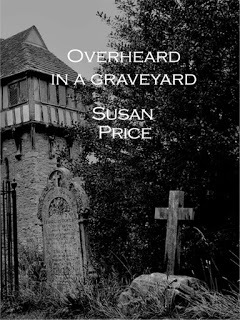
Overheard in a Graveyard
This is an excellent collection - varied, emotive and well-judged. Highly recommended. - Amazon review.
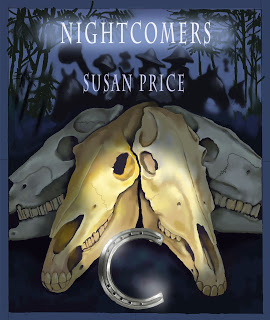 Nightcomers
Nightcomers
'Every tale shows the quality of the imagination, and the accuracy of the telling. What most impresses is the authority of Susan Price's voice: exact, rich or spare when necessary, able to evoke the Past without falsity, and the present without effort.'
(The Guardian.)
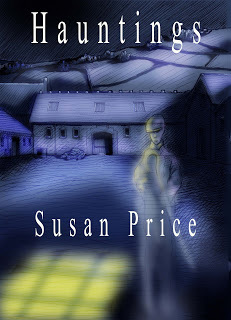
Hauntings
'This collection… has a depth of emotion that is at times disturbing.' Magpie,
 My friend, who wishes to remain anonymous
My friend, who wishes to remain anonymoushim, and I've been saving it up for today.
We were chatting, and he said, "I never used to believe in ghosts, but..." He wasn't going to get away without giving up the story after that.
He used to 'travel in computers and accessories' - that is, he used to travel round a circuit, trying to convince various shops and stories to buy and stock all sorts of things, from laptops and tablets to novelty USB sticks.
"You get to know various other salesmen in the same line," he said, "because you're always staying in the same cheap chain hotels and B&Bs. So, this trip, I was in ---- and staying at a ----- "
He told me the exact name and location of the hotel. But I'm not going to write it down here. I'm not looking to be sued.
"Anyway," he said, "when I looked into the restaurant that evening, I met up with a couple of other reps. I knew them slightly. One was in electronics, like me - the other was in sports gear. So we ate together and had a pint or two - but the thing was, when they saw my room number, they gave each other funny looks. "'You're not in room 265?' says the one.
"I said, 'Why? What's wrong with it? Gets a lot of noise, does it?'
"They went through the funny looks routine again. Shock, horror, he's in room 265. Are you going to tell him, or shall I? That sort of business. 'Come on,' I said. 'Out with it.' "'That room's haunted,' the computer bloke said. 'Ask if you can change it.' "'I wouldn't sleep in that room for a year's pay,' says the bloke in sports. "'What?' I says. 'Have you slept in it?' No, 'course he hadn't - but he'd heard about people who had, and - "'Oh, FOAF,'" I said. They didn't get it. 'Friend of a friend,' y'know. These things always happen to a friend of a friend, don't they? Never to the person telling you about it. I told 'em only kids believe in ghosts.
"In fact, I scoffed so much, they never got around to telling me what was supposed to happen in room 265 - we got off onto some other stupid subject. Aliens or Area 51 or something.
 'Aliens or Area 51 or something...' "Anyway, I went up to my room about eleven, and turned in soon after. It was a completely standard hotel room - y'know, little bathroom, a bed, a desk, a tv. I've lost count of the number of nights I've spent in hotel-rooms exactly like it. I had a quick shower, watched a bit of tv, switched off the light and settled down. I'd forgotten everything they'd said about ghosts. I was just starting to drift off, when the bed moved - and I was sleeping alone! There was a jolt, like someone had sat on the edge of the bed. I sat up like a jack-in-the-box. It was so real. I had no doubt at all that somebody was in my room and had sat on the edge of the bed. I snapped on the light. Nothing, of course. Just the hotel room, and my things on the desk and chair, where I'd left 'em. I got up and looked around. I had some idea that one of the others had got into my room and was playing tricks - but unless some member of the hotel staff had let them in, they couldn't have done. I hadn't heard the door open - and like most of these doors, they're heavy and fire-proof. Hard to open quietly. In the end, I decided that my imagination was playing me up. I'd been drifting off - it could have been a sort of half-dream. And even though I'd forgotten the talk about the room being haunted, it could have planted the idea in my head. "So I got back into bed and settled down again.I was asleep, or near as damn it, when there was a cold draught at my back - and then a puff of cold air on my ear, and a voice, a woman's voice, said, 'I'm glad the door's locked.'
'Aliens or Area 51 or something...' "Anyway, I went up to my room about eleven, and turned in soon after. It was a completely standard hotel room - y'know, little bathroom, a bed, a desk, a tv. I've lost count of the number of nights I've spent in hotel-rooms exactly like it. I had a quick shower, watched a bit of tv, switched off the light and settled down. I'd forgotten everything they'd said about ghosts. I was just starting to drift off, when the bed moved - and I was sleeping alone! There was a jolt, like someone had sat on the edge of the bed. I sat up like a jack-in-the-box. It was so real. I had no doubt at all that somebody was in my room and had sat on the edge of the bed. I snapped on the light. Nothing, of course. Just the hotel room, and my things on the desk and chair, where I'd left 'em. I got up and looked around. I had some idea that one of the others had got into my room and was playing tricks - but unless some member of the hotel staff had let them in, they couldn't have done. I hadn't heard the door open - and like most of these doors, they're heavy and fire-proof. Hard to open quietly. In the end, I decided that my imagination was playing me up. I'd been drifting off - it could have been a sort of half-dream. And even though I'd forgotten the talk about the room being haunted, it could have planted the idea in my head. "So I got back into bed and settled down again.I was asleep, or near as damn it, when there was a cold draught at my back - and then a puff of cold air on my ear, and a voice, a woman's voice, said, 'I'm glad the door's locked.'"I was standing by the room's door, with the light on and my heart pounding like Desert Orchid's on the winning stretch. I don't remember getting there.
"I was looking at the blandest of bland hotel rooms. Y'know: dark blue carpet, beige walls, white covers on the bed. Apart from my few things, it was neat and boring and clean - and like ten thousand other hotel rooms all over the world.
"My heart rate started slowing down, and I felt a bit of a fool. Fancy letting those two idiots get to me. And that place was so blah that the ghost of a vanilla yoghurt would have turned it down as not sinister enough to haunt.
"I had a drink from the fridge and watched a bit of late night telly. Listened to people tramping past in the corridor outside and slamming firedoors. After an hour, I went to bed again, feeling really shattered. This time, nothing was keeping me awake.
"Now imagine this. Imagine you're all warm and toasty - and an ice-cube touches you. I want you to really imagine that freezing touch. The way the shock jolts you. The way the ice clings to your skin. The way the shudder goes right through you to the other side.
"That's what woke me. Only it wasn't an ice-cube. It was a hand, a cold hand. On my chest. And an arm, reaching over me from behind. A woman was in bed with me, pressing against my back and reaching around to hug me - and she was icy, freezing. Like a randy snowman had climbed into bed with me.
"An icy kiss pressed against my neck - and that was when I raced into reception, at three in the morning, in my underpants.
"Don't remember anything else - except suddenly realising I was in reception, looking at the night-clerk, in nothing but my socks and Y-fronts. (Yes, I wear Y-fronts. Shut up.)
"I wouldn't go back upstairs either. The night-staff had to let me hide behind their desk and find me a coat to wear, while they went up and moved my luggage from room 265 to another room on
another floor.
"I didn't get any sleep that night. I kept thinking she might find out what room I'd moved to.
 'There's nothing I want to know...'
'There's nothing I want to know...'"The next morning, at breakfast, when my friends asked me how I'd slept - well, I opened my shirt and showed them the red-blue mark of a woman's hand on my chest. And the bruise on my neck.'"
"Did you ever find out anything about the ghost?" I asked. "I mean, was someone murdered in that room, or what?"
"The only thing I know about that ghost," he said, "is that she has great taste in men. Apart from that, there's nothing I want to know. And she won't be getting a second date."
And if you believe this is a true story, told to me by a friend, then I am your Granny's great-uncle Jim.Copyright Susan Price.

Overheard in a Graveyard
This is an excellent collection - varied, emotive and well-judged. Highly recommended. - Amazon review.
 Nightcomers
Nightcomers'Every tale shows the quality of the imagination, and the accuracy of the telling. What most impresses is the authority of Susan Price's voice: exact, rich or spare when necessary, able to evoke the Past without falsity, and the present without effort.'
(The Guardian.)

Hauntings
'This collection… has a depth of emotion that is at times disturbing.' Magpie,
Published on October 30, 2015 17:00
Susan Price's Nennius Blog
"I have made a little heap of all I've found..."
"I have made a little heap of all I've found..."
...more
- Susan Price's profile
- 71 followers



